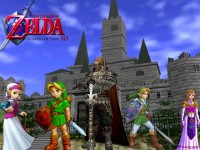May 8, 2014 Operation All The Zeldas! Ocarina of Time
 So this is probably going to be for some of you where this series peaks. Drawing from the backstory laid down by A Link to the Past, Ocarina becomes the fulcrum for the whole series’ mythology. If you haven’t played this game, you can still experience it fresh on the 3DS with some graphics enhancements. No seriously, go now. You can read my dithering once I’m not spoiling anything. Okay now that they’re gone, what is wrong with those people?
So this is probably going to be for some of you where this series peaks. Drawing from the backstory laid down by A Link to the Past, Ocarina becomes the fulcrum for the whole series’ mythology. If you haven’t played this game, you can still experience it fresh on the 3DS with some graphics enhancements. No seriously, go now. You can read my dithering once I’m not spoiling anything. Okay now that they’re gone, what is wrong with those people?
I kid.
Tough Video Games are a young medium, getting into the cannon of must-play games is pretty difficult. Ocarina is among some of the first 3D games, and among Big N’s excellent efforts at moving classic franchises forward. Like Super Mario 64, Ocarina feels a lot bigger than its predecessors. We wouldn’t see real open world games for another console generation, and we still haven’t gotten a true open world Zelda game, but Ocarina’s huge main field gave this game a lot of freedom. Though my personal favorite, mostly for nostalgia’s sake, is A Link to the Past, it’s hard to argue with the greatness of game that Nintendo has used as a basic template for every game that followed.
Much of that I think comes in the scope of the story. When Link awakes from a nightmare in Kokiri village, he is a child and has to prove himself worthy of being the Hero. Once he has proven that, making a mark on all the villages and races in Hyrule, he ends up seven years in the future as an adult. You then need to gather the spirits of the seven sages so you can defat Gannon and rescue Zelda. This was a neat idea. It draws on a similar idea of the Light/Dark World from A Link To The Past, but it shows the consequences of your actions. Once you can slide between the two times, you can manipulate things more directly.
The time feature leads to the most arcane part of the franchise’s lore, the split timeline. In the official time lines there are three separate timelines created by this game. The first is, Link is defeated leading to the original game, Adventure of Link, A Link to the Past, and Link’s Awakening timelines. (This also includes the Oracle games which came out after Majora’s Mask.) Then if Gannon is defeated there are two timelines that are created. The first draws from the child era, which leads to Majora’s Mask, Twilight Princess, and the Four Swords games. The adult end of the timeline continues as well, which leads to Wind Waker, Phantom Hourglass, and Spirit Tracks. Introducing time travel in any fiction is bound to make its cannon exponentially more convoluted.
The eponymous Ocarina may be one of the most memorable parts of the game. You learn the first measure or two of a tune and play it back to have some sort of magical effect. This includes moving forward and backward between time, summon your horse Epona, or warp around to the various Temples. It’s even used to solve some puzzles in dungeons. Though there were instruments in the earlier games, including the quest items in Link’s Awakening, but the idea of music becomes infused into the console titles from this point. Whether directly like the Harp in Skyward Sword, or more abstractly like the Howl Stones in Twilight Princess, the main console games have a musical component inspired by the Ocarina.
This game casts a long shadow over the franchise. Every game gets weighed against what arguably couldn’t be done again. 3D was the point where these games became worlds to explore, albeit in a limited fashion. While I won’t argue that the Zelda games have gotten any worse, it’s still among my favorite franchises, what I will say is that this is the last time the series really felt on the cutting edge. The same can be said for most of Nintendo’s franchises. If the games industry is a city full of skyscrapers, Nintendo is that last crazy Train Car diner that still makes hamburgers and shakes like it did in the 20’s.
Tags: Ocarina of Time, Operation All The Zeldas, Zelda
Written by: Michael McConnell
- 1 comment
- Posted under Videogames
Permalink # Joe
said
Joe
said
This was the first Zelda game I ever came in contact with, and actually the last one.
I never really got into the Zelda canon; I mostly remember watching my dad play as I got the game for Christmas and he was home for vacation.
I went back and played it in college but don’t remember beating the game ever.